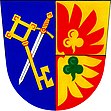Milonice
| Milonice | ||||
|---|---|---|---|---|
|
||||
| Basic data | ||||
| State : |
|
|||
| Region : | Jihomoravský kraj | |||
| District : | Vyškov | |||
| Area : | 499 ha | |||
| Geographic location : | 49 ° 10 ' N , 17 ° 4' E | |||
| Height: | 250 m nm | |||
| Residents : | 360 (Jan 1, 2019) | |||
| Postal code : | 683 33 | |||
| License plate : | B. | |||
| traffic | ||||
| Street: | Nesovice - Bohdalice | |||
| structure | ||||
| Status: | local community | |||
| Districts: | 1 | |||
| administration | ||||
| Mayor : | Ladislav Grim (as of 2010) | |||
| Address: | Milonice 118 683 33 Nesovice |
|||
| Municipality number: | 593338 | |||
| Website : | www.milonice.cz | |||
| Location of Milonice in the Vyškov district | ||||

|
||||
Milonice (German Pflaumendörfl , also Millonitz ) is a municipality in the Czech Republic . It is located five kilometers east of Bučovice and belongs to the Okres Vyškov .
geography
Milonice is located in the southwestern foothills of the Litenčické vrchy at the transition to the Ždánický les ( Steinitzer Forest ) in the valley of the Pavlovický creek. To the south lies the Litava valley . The Kopánky (349 m) and Soudny (328 m) rise to the east, the Nebštich (377 m) to the south and the Černecký hájek (355 m) and Milonický hájek (344 m) to the west. To the north of the village is the large fish pond Uhřický rybník.
Neighboring towns are Uhřice and Komorov in the north, Chvalkovice and Nemochovice in the north-east, Dobročkovice and Brankovice in the east, Nové Zámky in the south-east, Nesovice and Letošov in the south, Nevojice and Vícemilice in the south-west, Černčín in the west, and Kojátky and Rošardičoutky in the north-west.
history
The first written mention of the village took place in 1349. The name of the place derives from its reasons, the Vladiken family Miloň. The existence of a fortress, a courtyard and a bathhouse is recorded from 1360. There is evidence of a pastor in Milonice since 1397. Before 1420 the Bystřice von Ojnice acquired the village and connected it to their estates around Bučovice. Milonice was in the middle of the 15th century the seat of Mikuláš Bystřice from Ojnice and Milonice, who in 1446 Kryštof from Ojnice assigned the free farm and the mill in Uhřice. The transfer, which bypassed the succession, led to considerable disputes within the family. Ultimately, Kryštof von Ojnice prevailed and had this entered again in the land table in 1464 . In the 16th century the church became utraquist. At that time the Moravian Brothers established the first school in Milonice. The neighboring settlement became extinct in the middle of the 16th century and its corridors were closed to Milonice. In the course of time the place was also referred to as Millonitz , Pflaumendörfel or Pflaumendörfl . After the Thirty Years' War, a Catholic priest was reinstated in Milonice in 1654. The villages of Uhřice, Dobročkovice, Nesovice, Nové Zámky and Šardičky were also parish at this time. The oldest local seal dates from 1688. In 1780 Prince Franz Josef I von Liechtenstein bought the Milonice estate and added it to his rule Butschowitz. Šardičky was repared to Butschowitz in 1786. Prince Johann I Josef von Liechtenstein had a new church built in 1805. The old church was demolished and the parish garden was created in its place.
After the abolition of patrimonial Milonice formed from 1850 a municipality in the district administration Wischau . In 1877 a school was built in Uhřice, previously Milonice was also a school location for this village. In 1890 the Liechtensteiners united the lords of Steinitz and Butschowitz to form Gut Butschowitz-Steinitz; this remained in the primogeniture of the princes of Liechtenstein until the end of the Second World War. In 1921, 531 people lived in the 106 houses in the village. Between 1950 and 1960 the municipality belonged to the Okres Bučovice and after its abolition came back to the Okres Vyškov at the beginning of 1961. 1964 Milonice was merged with Uhřice to form a municipality Milonice-Uhřice . This dissolved again in 1990. The school was closed in 1996 due to insufficient student numbers. Since 2001, Milonice has had a coat of arms and a banner with the Liechtenstein eagle wing and the attributes of the local cartridges Peter and Paul.
The Uhřický rybník pond is used as a breeding ground for Pohrlitz carp (Pohořelický kapr).
Community structure
No districts are shown for the municipality of Milonice. The settlement Rošťoutky ( Rosstiautek ) belongs to Milonice .
Attractions
- Parish church of St. Peter and Paul, built 1805–1807 under Johann I Josef von Liechtenstein
- Statue of St. John of Nepomuk, next to the church
- Statue of the Virgin Mary on the outskirts of Nesovice
- Komorov Castle, northeast of the village, built 1811–1812 in Empire style for Johann Pagatsch von Paburg, it is currently in a ruinous state
- Roviny and Hašky nature reserves, west of the village
- Malhotky nature reserve, southwest of Milonice
Individual evidence
- ↑ Český statistický úřad - The population of the Czech municipalities as of January 1, 2019 (PDF; 7.4 MiB)

